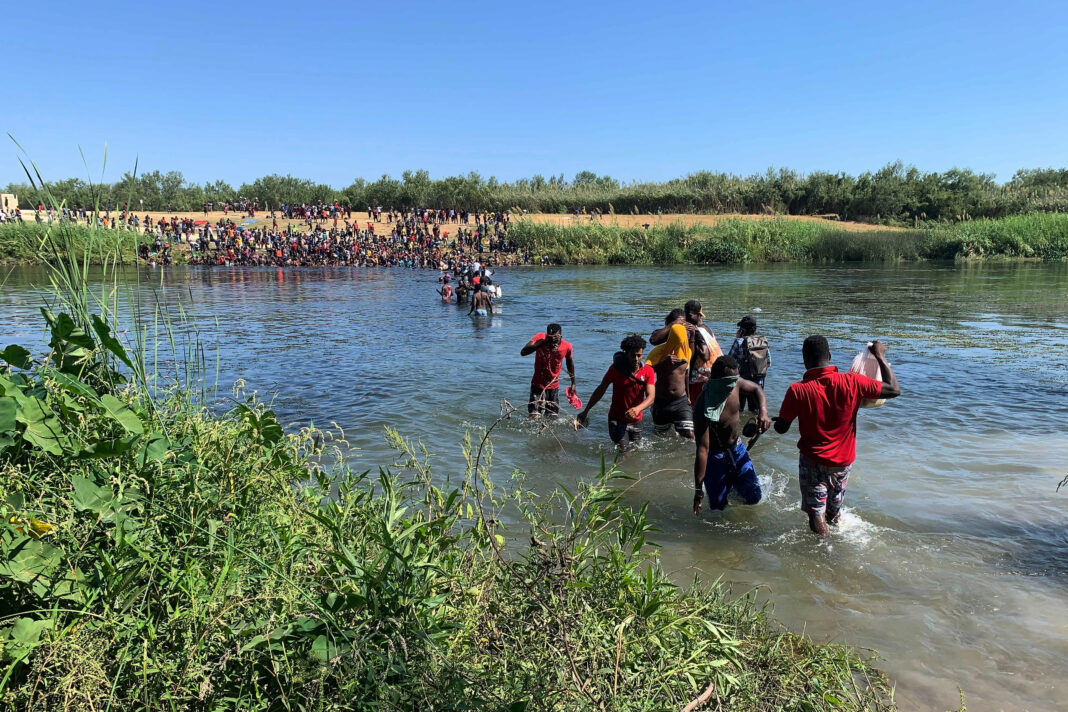Several groups of migrants, originally from Haiti, arrived in Reynosa over the weekend intending to head to Cuidad Acuña to join the thousands of others seeking entry into the U.S.
Federal, state and local law enforcement struggled to manage the apprehension of a rising number of migrants — 14,000 by Sunday — who converged under a bridge in Del Rio.
To meet rising demand in human resources, the port of entry and checkpoints in Del Rio were closed. Some checkpoints were also left unmanned in Laredo, but have been re-opened as of Saturday.
On Sunday, U.S. Border Patrol Chief Raul Ortiz announced U.S. Customs and Border Protection surged 600 agents, officers and Department of Homeland Security volunteer personnel to the Del Rio area.
Many of the migrants have been unable to get processed, but in the last two days, Ortiz said during a news conference Sunday, about 3,300 people were moved to other locations for processing.
Many will be turned away under the CDC’s public health code orders. Deportation flights started on Sunday and more flights will be added in the coming days.
Yet, many migrants are still en route.
Naomi, a 45-year-old mother traveling with her child and husband, arrived in Reynosa on Sunday. Although she is originally from Haiti, the family lived in Chile for the last four years, and 15 years in the Dominican Republic before that.
It took them about a month to make the trip to the border, but they aimed for Cuidad Acuña, a border city across from Del Rio.
“For me, the border is Acuña,” Naomi said, adding, “or Tijuana, like we heard from someone else.”
They ended up in San Fernando with a heading to Reynosa, but Naomi said her family didn’t realize Reynosa is also a crossing point to the U.S.
“We don’t know where we’re going. We just know we have a destination to Acuña to cross the river to get to the United States. We came walking like the blind,” Naomi explained.
Ortiz said they suspect word of mouth and previously traveled routes led to the increase at that part of the border.
“Haitians and folks from Western Africa traditionally cross in the Del Rio sector area, because they have known individuals previously who have crossed in this area, they say the community across the border in Acuña is relatively safe, so traditionally it’s because of word of mouth.”
Naomi’s family was one of over 100 others who travelled to Reynosa this weekend up through San Fernando, a city about two and half hours south of the Tamaulipas border.
Several nongovernmental organizations, like the Sidewalk School, headed to San Fernando on Saturday to help the migrants who were told by the Mexican National Guard they could not take commercial buses.
Felicia Rangel-Samponaro, a cofounder with Sidewalk School, said she witnessed the federal officers escort the dozens of walking migrants down the road, even stopping traffic to ensure they would not be struck by traffic.
Some non-governmental organization volunteers used their vehicles to take them to the Tamaulipas border, but as they approached the city limits of Reynosa the Mexican National Guard changed course.
Rangel-Samponaro and Victor Cavazos, the Sidewalk School cofounders, and the other drivers taking migrants in their vehicles were pulled over. About 50 armed guardsmen lined up around the vehicle and demanded the migrants leave with them.
Some were placed in government vans, processed, and deported to the southern Mexican border in Tapachula, according to one of the migrants who communicated with Rangel-Samponaro. Others managed to stay in Tamaulipas and ended up at the encampment in Reynosa.
Haitian families, like Naomi’s, were pulled aside by humanitarian aid workers and invited to stay at a migrant shelter in Reynosa. Though there are thousands of other migrants living in the encampment waiting to go into the shelter, migrants from Haiti face great challenges.
“They’re just in a more vulnerable position, since they are easier to spot,” Rangel-Samponaro said. Criminal organizations often seek to kidnap and extort migrants, and often racially profile those who speak or look different.
“They don’t speak the language. It’s harder for them to get jobs to support themselves while they’re here in Mexico. People don’t want to rent apartments to them,” Rangel-Samponaro said.
Naomi and her family intended to make their way to Acuña, but she said a premonition kept her from pursuing that journey. Instead, they ended up at the Reynosa shelter.
At around 3 p.m. Sunday, Naomi received a phone call from a relative advising her that Haitians in Del Rio were getting deported. If the family had persisted, they could have ended up in a country Naomi hasn’t lived in for nearly two decades.
“I don’t know that area any more. I can’t go,” Naomi said.
Crossings in Del Rio came to a stop on Sunday, Chief Ortiz announced during the news conference. Ortiz then addressed migrants directly, though in English, and said, “they will not be allowed to enter the United States. They will be removed. They will be sent back to their country of origin as mandated under our current law.”
About two hours after that conference ended, the message percolated through the migrant networks and reached Naomi.
“I want to stay here for a while,” Naomi said, referring to Reynosa, “until things get better.” She plans to stay put until an attorney who speaks her native tongue visits later this week.
When the attorney arrives, migrants who ended up stalled in a city where they do not know its geolocation, risks and economic situation will be better informed of their options.




